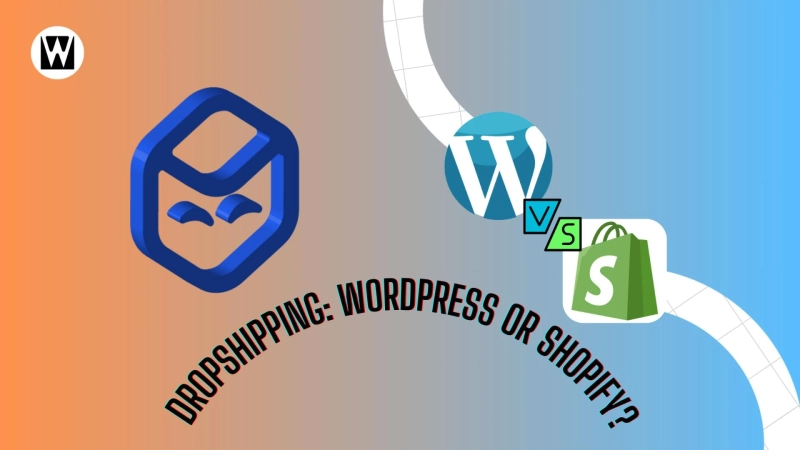Starting a dropshipping business has become one of the most accessible ways to step into the world of e-commerce. With no need for inventory management or large upfront investments, it’s an appealing model for budding entrepreneurs.
Dropshipping is a business model where you, as a retailer, sell products to customers without maintaining inventory. Instead, you partner with wholesalers who deliver products directly to your customers under your brand name. The process is simple: a customer places an order on your e-store, and you forward the request to the supplier, who handles fulfillment. This model is popular due to its flexibility, low startup costs, and minimal inventory management. It’s ideal for entrepreneurs with limited resources to start an online business.
WordPress and Shopify: Overview and Key Features
Features of WordPress for Dropshipping
- Customization: WordPress, when used with WooCommerce, provides great flexibility and many options for customization. You can create a store that fits your needs by using thousands of plugins and themes.
- WordPress is a free platform, which makes it a cost-effective option. Still, expenses for hosting, plugins, and maintenance can increase over time.
- WordPress is known for being very SEO-friendly, which helps your dropshipping store rank better in search engines.
Features of Shopify for Dropshipping
- User-Friendly: Shopify is a hosted platform that makes it easy to create a store using a simple drag-and-drop system.
- Included Features: Shopify provides various built-in tools such as payment options, inventory tracking, and marketing resources, so you don’t need extra third-party services.
- Dropshipping Integration: Shopify works well with popular dropshipping apps like Oberlo and Spocket, making it easier to find products and manage orders.
Comparing WordPress and Shopify for Dropshipping
Ease of Use: WordPress vs Shopify
Shopify is made for beginners, featuring a simple interface and round-the-clock customer support. On the other hand, WordPress needs more technical skills but gives you more control over how your store works.
Scalability and Flexibility
WordPress provides greater flexibility for growing your business, particularly for users with technical skills who can use custom plugins and features. On the other hand, Shopify's scalability is simpler but might need more expensive plans as your business expands.
Payment Gateway Options and Transaction Fees
Shopify supports over 100 payment gateways but charges transaction fees unless you use Shopify Payments. WordPress, with WooCommerce, offers broader payment gateway integration without additional costs.
SEO Capabilities and Marketing Tools
WordPress is a powerhouse for SEO due to its customizable structure and plugins like Yoast SEO. Shopify has built-in SEO tools but doesn’t offer the same level of control as WordPress.
Plugin and App Ecosystem
WordPress has an extensive library of plugins for everything from analytics to advanced marketing. Shopify’s app store is also robust, with apps explicitly tailored for eCommerce and dropshipping.
Migrating Between Platforms
WordPress to Shopify Migration: Why and How?
Moving from WordPress to Shopify is a smart decision for drop shippers who want an easier setup and improved compatibility with dropshipping apps. The steps include exporting your data from WordPress, importing it into Shopify, and setting up your new store.
Benefits of Moving from WordPress to Shopify for Dropshipping
- Easy Management: Shopify offers a complete solution that makes running your store simpler.
- Designed for Online Sales: Shopify is built for eCommerce, providing a better experience for both you and your customers.
- Time-Saving: Shopify’s automation tools streamline operations like inventory updates and order fulfilment.
Challenges When You Migrate WordPress to Shopify
- Cost Considerations: Shopify's subscription prices may be more expensive than hosting on WordPress.
- Less Flexibility: Shopify's templates offer fewer customization options compared to WordPress themes.
- Risk of Data Loss: To prevent losing important data, careful planning is needed for a smooth migration.
Final Thoughts: Which Platform is Right for Your Dropshipping Business?
The choice between WordPress and Shopify depends on your needs. If you want more options for customization and control, go with WordPress. If you like ease of use and features for dropshipping, Shopify is a good choice. Think about your technical skills, budget, and future business goals before deciding.
FAQs
Can I switch from WordPress to Shopify for Dropshipping?
Switching platforms can make things easier for those seeking a simpler experience. Use migration tools or seek assistance from experts to ensure a smooth transition.
Which platform offers better profit margins?
Profit margins depend on factors like transaction fees and operational costs. WordPress may offer better margins due to lower expenses, but Shopify’s tools can help increase sales.
Is WordPress cheaper than Shopify for dropshipping?
WordPress can be more cost-effective upfront, but maintenance and plugin costs can add up. Shopify has higher monthly fees but includes hosting and integrated tools.


